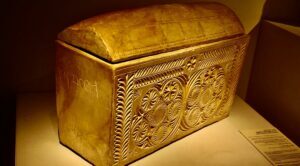
Few cities and regions of the world can match the significance and draw of Jerusalem with the public and scholars alike. In this ancient city, some of the world’s most defining historical events and figures have played out their stories, influencing generations through the ensuing centuries, especially concerning religious beliefs and practices. It therefore goes without saying that historical and archaeological research and publication related to the salient events and figures of historical Jerusalem and its regional context have taken on intense popular interest, as well as some intense scholarly and ecclesiastical debate. The cultural, emotional and ‘spiritual’ roots run deep.
Dr. James Tabor, one of the world’s foremost academic authorities on the Late Second Temple period (aka the Herodian period) Judaism and early Christianity, has offered a new video series he entitles “Jesus Archaeology”. Free to the public, the series focuses on how ancient texts, historical and archaeological sites, and ancient artifacts shed light on the rise of Christianity and the context in which it occurred. It also explores the period extending from at least 100 years before the time of Jesus through the century in which his crucifixion occurred. Of particular note here is video no. 1, entitled Ten Jerusalem Tombs from the Time of Jesus (See complete video below). Here, Tabor reviews and summarizes, with photographic images and illustrations, ten extraordinary burial cave tomb discoveries in the Old City area that relate to the context and events around the time of the Late Second Temple, the time period where Jesus enters the flow of time as it is now documented in historical and biblical records.
The Ossuary of Caiaphas
As is known to many who have a knowledge of the events as accounted in the Canonical gospels of the New Testament, Joseph, son of Caiaphas, presided as High Priest over the trial of Jesus before his crucifixion. A number of scholars suggest that an ornate ossuary (stone box that carries bones of the deceased), discovered with 11 other ossuaries in a tomb accidentally revealed through construction work south of Jerusalem in 1990, contained the skeletal remains of Joseph. Although the identification of the find has been subject to scholarly dispute, the discovery is one of the most important material objects relating to the times in which Jesus lived. Decorated with very ornate etchings — a practice usually reserved for a high status individual — the ossuary contained collectively the remains of two infants, two teenage boys, an adult woman and a man around 60 years old. Scholars suggest that the remains of the 60-year-old man was probably Joseph, son of Caiaphas, as the ossuary exterior was inscribed “Yehosef bar Qayafa” on the long side and “Yehosef bar Qafa” on the narrow side.
The tomb and the ossuary of Caiaphas that it contained is one example among 9 other tomb discoveries Tabor discusses in the first installment of his video series. Each discovery excites the imagination in equal measure, providing a fascinating window on the lives and times of First Century Jerusalem, a critical and tumultuous period in religious history.
___________________________
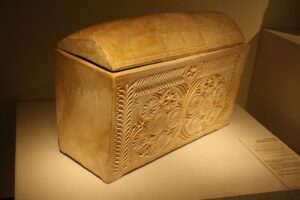
The Ossuary of Caiaphas, the High Priest. Note the name inscription on one side. BRBurton, CCO 1.0 Universal, Wikimedia Commons
______________________________
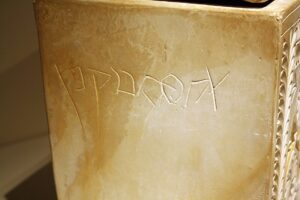
Detail view of the Caiaphas ossuary inscription. BRBurton, CCO 1.0 Universal, Wikimedia Commons
___________________________
Following is a summary of the tomb discoveries Tabor discusses:
- The Ossuary of Yehonatan ben Yeshua (Jonathan son of Yeshua) — This is an ornately inscribed but unprovenanced bone box that came into the possession of Tabor and which awaits publication and return to the collection under management of the Israel Antiquities Authority.
- The Ossuary of Caiaphas (summarized above).
- The Tomb of Bethphage on the Mount of Olives — A tomb with a circular rolling blocking stone at its entrance. The tomb features early Christian ‘graffiti’ on an internal wall surface. It is suggested by Tabor as a likely candidate for the first (temporary) tomb in which Jesus was laid directly after his crucifixion (not to be confused with the second, more permanent tomb belonging to Joseph of Arimathea as mentioned in the Gospel account).
- The Tomb of the Shroud in Hinnom Valley — Located just south of Jerusalem, this tomb was looted when first encountered by Tabor and archaeologist colleague Shimon Gibson. Here, skeletal remains and an intact burial shroud was found within the tomb, a very rare discovery. Also a first, the skeletal remains revealed the deceased suffered from advanced leprosy. The shroud was carbon dated to the 1st century AD.
- The Talpiot “Jesus Family” Tomb — First discovered during clearing of the area of Talpiot south of Jerusalem for construction of condominiums in 1980, this tomb contained 10 ossuaries. Six of the ossuaries were inscribed with names identifiable with names known to be associated with Jesus and his family, including the name of Jesus himself.
- The Talpiot “Resurrection Tomb” — Discovered just steps away from the “Jesus Family Tomb” and now situated beneath a condominium, this tomb was initially investigated but subsequently re-explored 25 years after its discovery by a team using a robotic arm and camera device. The tomb contained ossuaries with inscribed images and inscriptions relating (by interpretation) to the raising of the dead, or resurrection.
- The James Ossuary — This famous ossuary, and the story behind it, featured the inscription, “James, son of Joseph, brother of Jesus”. It was brought to light in 2002 from an antiquities dealer and from the beginning became the center of a debate firestorm. Recent geochemical studies have shown that the ossuary likely originally came from the “Jesus Family Tomb” described above.
- The Ossuary of Simon and son Alexandros — One of a number of ossuaries discovered through excavation in 1941 of a tomb by archaeologists in the Kidron Valley near Jerusalem. It featured inscriptions of the names of Simon the Cyrenian (suggested to be the Simon of Cyrenia of the New Testament biblical account), and his son Alexandros.
- The Abba Tomb — This tomb was found just north of Jerusalem in 1970. It is where Abba, son of Eliza the Priest, and Mattathia son of Judah were buried. Tabor suggests that this Mattathia (Matthew) was in fact the last Maccabean (Hasmonean) king, Antigonus (aka Mattathia or Mathew). The ossuary associated with Antigonus contained nails used for crucifixion, along with skeletal remains.
- The Tomb of Yehochanan — This tomb was found north of Jerusalem not far from the Abba tomb in 1968. It contained the remains of a man who, based on the evidence found in the tomb, was crucified. The evidence uncovered provided new insights on how individuals were crucified during the Late Second Temple period in Jerusalem.
- Cave 2001 at Masada — In the 1960’s archaeologists found 25 skeletons of men, women and children who were once living in a cave at the southern tip of the summit of Masada near the Dead Sea during the time of the famous siege of Masada. Suggested to have been among the defenders of Masada during the siege, Tabor theorizes that they were the remains of what was left of the Hasmonean priestly royal family based on DNA analysis.
Tabor hopes to realize future DNA analysis of embedded residues within ossuaries such as those described here to develop family profiles for further study.
________________________________
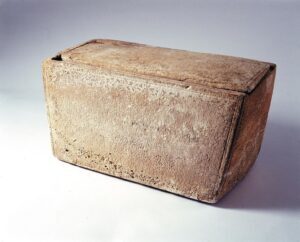
The James ossuary. Paradiso, Wikimedia Commons
________________________________

Inscription detail, James ossuary. Paradiso, Wikimedia Commons
________________________________
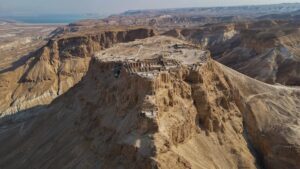
Aerial view of Masada. Samirsmier, Pixabay
________________________________
Cover Photo, Top Left: The Ossuary of Caiaphas, the High Priest. BRBurton, CCO 1.0 Universal, Wikimedia Commons
For more details about the “Jesus Family Tomb” and the “Resurrection Tomb”, see the article, In Search of the Historical Jesus, previously published in Popular Archaeology Magazine.
________________________________
Advertisement




